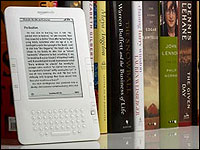
Books, writing and text aren’t going away, but with the proliferation of digital devices, tablets and smartphones, along with the apps that serve them, the written word is evolving in new and intriguing ways.

In fact, the evolution of digital books is, in some ways, making reading cool again.
“With Kindle, readers read more,” maintained Stephanie Mantello, the senior PR manager for Amazon’s Kindle.
“Kindle owners buy 3.3 times the number of books they purchased prior to owning a Kindle,” she told TechNewsWorld.
Increasingly, though, the meanings of terms like “book” and “reading” are changing. What, for instance, do you call a cross between a video and a book? Well, one company calls it a “Vook.”
Stories in Text and Video
Founded by Bradley Inman in 2008 to incorporate video into books, Vook is a leader in the nascent field of multimedia, video-enhanced books.
“He’d always had the idea that video could really benefit some kinds of books,” Mike Arnot, VP marketing at Vook, told TechNewsWorld.
One of the company’s first Vooks was a Sherlock Holmes work, The Man with the Twisted Lip, which included, along with the written text of the novel, a specially commissioned documentary about London at the time the story was set.
Vook creates some of its own content, such as TextVooks, which cover a variety of historical topics and include animated video along with text. The company also works with media companies such as ABC and NBC and publishers, including HarperCollins, to bring their content to video book format.
Vooks are available across a wide variety of platforms, including iPhones, iPads, and Android devices, as well as Amazon’s Kindle and Barnes & Noble’s Nook.
iPads and other tablets, in particular, have changed the playing field entirely and created increasing demand for Vook content.
“When the iPad came along, it just took off,” said Arnot. “This is the kind of content that works so well on a tablet device.”
Video combined with text is a powerful tool, particularly for instructional purposes.
“Instead of just reading about golf, get a book with text and also videos that show golf swings,” said Arnot. “In the right places, video makes the written text sing.”
Vooks don’t do away with the need for written text, but enhancing that text with videos creates an entirely new kind of experience.
“It’s an exciting and energizing experience,” said Arnot. “It’s very different from just plain reading.”
Digital Book Signing
And then there’s the problem of how to have an author sign a digital book. Robert Kiyosaki — author of bestselling personal finance book Rich Dad, Poor Dad: What the Rich Teach their Kids about Money – That the Poor and Middle Class Do Not! and, most recently, Unfair Advantage: The Power of Financial Education — had begun to encounter people at book signings who handed him their Kindle to autograph, and he wasn’t sure what to do about that.
The IT department at Kiyosaki’s Rich Dad Company, though, had some ideas. It set up a live Facebook chat last week allowing participants to bring up a pop-up window that asked for name and contact information, along with the dedication that they wanted Kiyosaki to make for them in the book.
Then participants were directed to an Amazon page where they placed an order for a Kindle version of the book. Within three-to-five business days, they received a special digital version of the book, including a unique cover, a bonus chapter, and a special page featuring Kiyosaki’s signature and handwritten dedication.
“We started brainstorming about how we could personalize this experience,” Shane Caniglia, Director of IT for the Rich Dad Company, told TechNewsWorld. “We wanted to make it really easy for the participant.”
It wasn’t the company’s first foray into multimedia books, however. Unfair Advantage is also available as an enhanced digital book through Apple’s iBookstore, including the full written text of the book accompanied by 17 two-to-three-minute videos of financial experts explaining some of the book’s key points.
The videos help readers to understand the content better than they might by reading text alone, Caniglia said.
“We learn in many different ways” he explained. “We wanted to implement videos because that’s another way people can learn. People learn through the dual experience of reading and watching the videos.”
Above all, enhancing the books with video makes the experience of reading richer, he emphasized. “It’s a way that Robert personalizes his communication with the reader. Through the use of current technology, we want to personalize the material and make it unique.”





















































